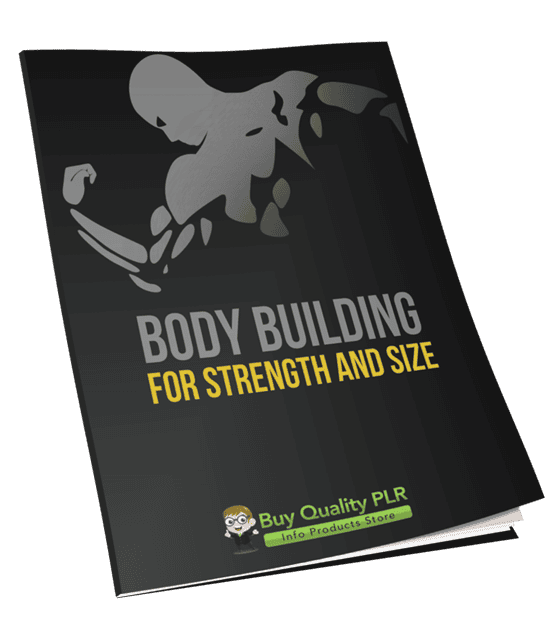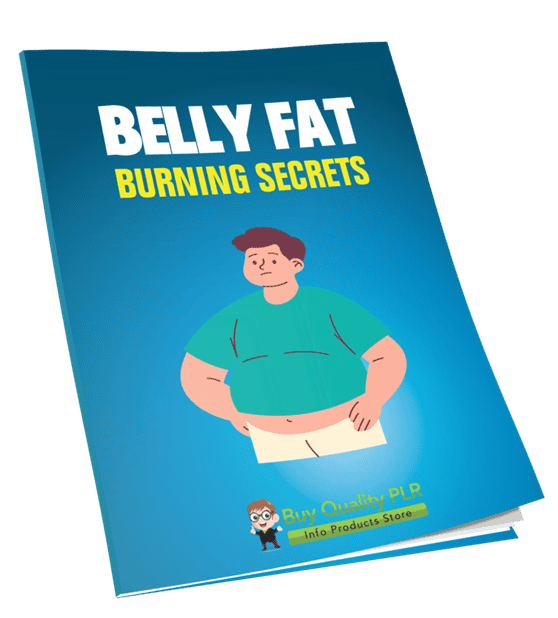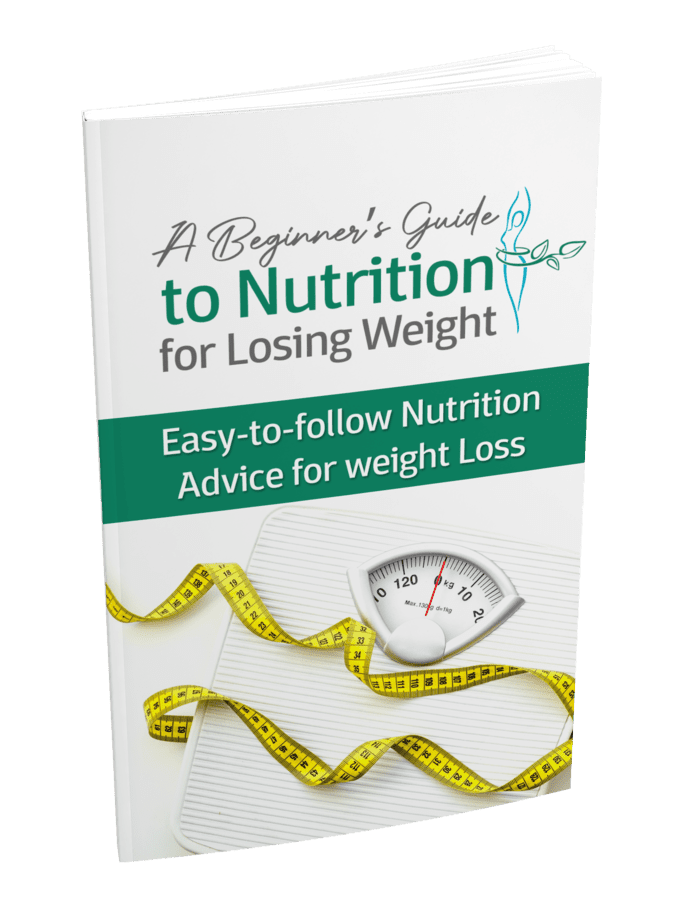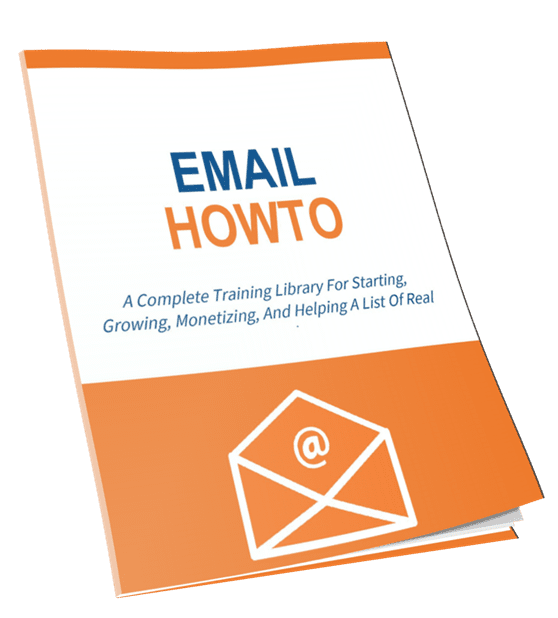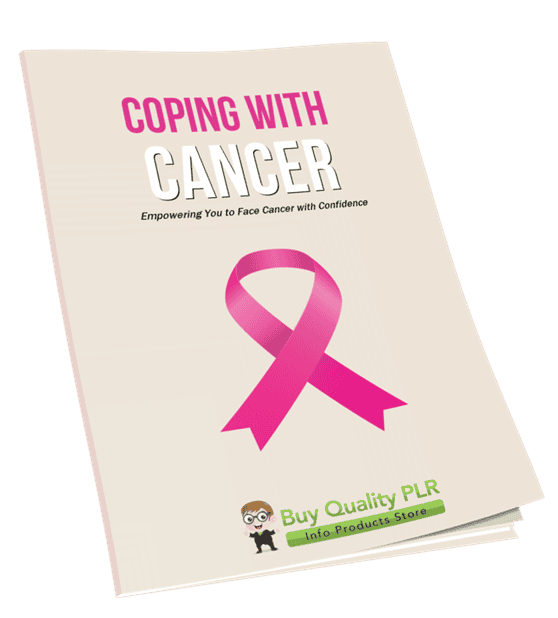
Coping With Cancer PLR Course 20k Words
in Health PLR , Health PLR eBooks , PLR Checklists , PLR eBooks , PLR eCourses , PLR List Building Reports , Premium PLR , Premium PLR eBooks , Premium PLR Reports , Premium White Label Brandable PLR Coaching Courses , Private Label Rights ProductsChoose Your Desired Option(s)
has been added to your cart!
have been added to your cart!
#copingwithcancer #cancersupport #healthplrcourse #plrcontent #cancerawareness #wellnesscontent #emotionalhealth #privatelabelrights #healtheducation #cancercare
Coping With Cancer: A Compassionate Step-by-Step Guide for Patients and Loved Ones Navigating the Cancer Journey
Empowering You to Face Cancer with Confidence
Cancer is a difficult journey, but you don’t have to face it alone. Whether you are dealing with a recent diagnosis or supporting a loved one through treatment, Coping With Cancer offers you the tools and guidance to handle every aspect of the cancer journey with strength and grace. This comprehensive PLR course is designed to help you manage the emotional, physical, and mental challenges of cancer, giving you strategies for long-term coping, healing, and hope.
By the end of this course, you will have a personalized roadmap that empowers you to face the cancer journey with confidence, resilience, and emotional well-being.
Presenting…
Coping With Cancer PLR Course 20k Words
What’s Included in the Coping With Cancer PLR Course
The Coping With Cancer course provides a step-by-step guide with actionable strategies for both patients and caregivers. With a focus on holistic support, this course helps you manage everything from diagnosis to recovery, with tips on emotional well-being, lifestyle changes, and building a strong support system.
Module 1: Understanding Your Diagnosis
Goal: To help you calmly process the diagnosis and prepare mentally for the journey ahead.
- Step 1: Give Yourself Time to Breathe
Allow yourself to process the news at your own pace. It’s okay to feel overwhelmed—give yourself permission to just breathe. - Step 2: Get the Facts
Ask your doctor to explain your diagnosis in simple terms. Learn about the type, stage, and treatment options available to you. - Step 3: Build a Support Circle
Surround yourself with family, friends, and support groups. You don’t have to face this alone. - Step 4: Set Your Intentions
Clarify your mindset and goals for your cancer journey. Whether you want to stay informed, stay active, or journal, setting intentions will empower your approach.
Module 2: Navigating Treatment
Goal: To equip you with tools and knowledge to handle your treatment with strength and confidence.
- Step 1: Understand Your Options
Learn about treatment options, including surgery, chemotherapy, radiation, and immunotherapy. Make informed decisions with your medical team. - Step 2: Plan for Appointments
Organize your treatment calendar, and be sure to ask questions and bring someone with you for support. - Step 3: Manage Side Effects Gently
Learn how to manage side effects like fatigue, nausea, and pain using practical strategies. - Step 4: Celebrate Small Wins
Celebrate the completion of treatments, and remind yourself of your strength and progress throughout this journey.
Module 3: Emotional & Mental Wellbeing
Goal: To guide you in caring for your mental and emotional health during this time.
- Step 1: Feel What You Feel
There’s no right or wrong way to feel. Embrace your emotions without judgment—this is your healing journey. - Step 2: Talk to Someone
Talk to a counselor, therapist, or friend. Sharing your emotions helps lighten the mental load. - Step 3: Find Healthy Distractions
Engage in activities that bring you comfort and joy, whether it’s reading, music, or light exercise. - Step 4: Practice Self-Compassion
Be kind to yourself, as you would be to a loved one going through the same thing. Self-compassion is a crucial part of healing.
Module 4: Lifestyle & Wellness Support
Goal: To support your body and mind with everyday healthy habits during and after treatment.
- Step 1: Focus on Nutrition
Learn how to nourish your body with foods that support healing. A balanced diet is key during treatment. - Step 2: Move When You Can
Gentle exercise, like walking or yoga, helps circulation and boosts mood. Listen to your body and move at your own pace. - Step 3: Prioritize Rest
Your body needs rest to recover. Make time for naps and quality sleep. - Step 4: Create a Healing Environment
Your space should feel peaceful and healing. Incorporate calming elements like soft lighting, soothing scents, and comforting sounds.
Module 5: Looking Ahead – Hope & Resilience
Goal: To help you rebuild, reflect, and renew your life with hope—no matter where you are in your journey.
- Step 1: Reflect on the Journey
Take time to reflect on how far you’ve come. Every day you push through is a victory. - Step 2: Embrace New Normals
Life may look different now, and that’s okay. Embrace the changes with grace and build new routines that fit your post-cancer life. - Step 3: Share Your Story
Your experience can inspire others. Consider sharing your journey through writing, speaking, or mentoring. - Step 4: Set New Goals
Dream about the future. Whether it’s a hobby, traveling, or reconnecting with someone, setting new goals will help you reclaim your life.
What’s Included in Your Purchase
When you purchase Coping With Cancer PLR Course, you’ll also receive the following valuable bonuses:
- Coping With Cancer Checklist
A 568-word checklist to summarize all the steps and tips you’ve learned in the course. - Coping With Cancer FAQs
A 809-word FAQ page answering common questions about cancer treatment, emotional coping, and support systems. - Sales Page for Coping With Cancer
A 545-word sales page that you can use to sell the course to your audience or build your own business around it.
How You Can Profit from This Course
The Coping With Cancer PLR Course is a comprehensive, ready-to-sell PLR product that offers endless possibilities for monetization:
- Sell the course as-is: Market the course directly to your audience through your website, social media, or email list.
- Create a membership site: Offer this course as part of a monthly subscription service, providing members with ongoing support and educational materials.
- Convert the course into a video series: Use the content to create a multi-part video course or webinar.
- Offer the course as a lead magnet: Give away a portion of the course for free to grow your email list, and sell the full course later.
- Bundle with other health and wellness PLR products: Increase the perceived value by combining this course with other related products, offering a complete solution for cancer support.
Licensing Terms
The Coping With Cancer PLR Course comes with full resale rights, which means you can:
- Sell the content as-is or modify it to make it your own.
- Break it down into smaller reports and sell them individually ($10-$20 each).
- Bundle it with other content to create higher-value packages ($47-$97).
- Create a membership site and charge a subscription fee.
- Repurpose the course into other formats like videos, audios, or printed materials.
What You Can’t Do with This Course
- Resell the PLR rights: You cannot give your customers the ability to resell or pass on PLR rights.
- Give away the course for free: The content must be sold. You can excerpt parts of it as lead magnets or blog posts, but the full course cannot be given away for free.
- Offer 100% affiliate commission: The maximum affiliate commission you can offer is 75%.
Start Empowering Yourself and Others Today!
If you or someone you know is navigating the cancer journey, this Coping With Cancer PLR Course is an invaluable resource. It provides the information, support, and practical tools necessary to handle the challenges of cancer with grace and resilience.
For only $14.99, you can start creating a life filled with hope, healing, and a brighter tomorrow.
Click here to purchase the Coping With Cancer PLR Course and start your journey toward healing today!
has been added to your cart!
have been added to your cart!
Here A Sample of Coping With Cancer PLR Course
A compassionate step-by-step guide for patients and loved ones navigating the cancer journey
Module 1: Understanding Your Diagnosis
Goal: To help you calmly process the diagnosis and prepare mentally for the journey ahead.
Step 1: Give Yourself Time to Breathe
Take a deep breath. It’s okay to feel overwhelmed. You don’t have to figure everything out in one day. Pause and allow yourself to feel.
Course Instruction & Description (For International Learners and Course Creators):
Being diagnosed with cancer can be one of the most emotionally intense and life-altering experiences a person may ever face. In this very first step of the course, we are not going to rush toward decisions, treatments, or even next steps. Instead, we begin with something simple, yet incredibly powerful: a pause.
This module opens the door to the emotional processing of a cancer diagnosis with gentleness, clarity, and cultural sensitivity that works across global contexts. Regardless of your nationality, culture, age, or gender—the immediate emotional reaction to the word “cancer” is valid and deserves space, not judgment.
1. Acknowledge the Shock
It is completely normal to feel like the world has stopped. You may feel numb, frightened, confused, or even disbelieving. Some people feel an urge to act immediately—research everything, call everyone, start making decisions. Others may freeze or feel emotionally paralyzed. Both are valid responses.
As course creators or facilitators, ensure your learners understand that emotional processing is not linear. It may come in waves—first denial, then sadness, then anger, or even guilt. It’s okay if they don’t feel anything at all right away. Encourage them to simply acknowledge what they are feeling, without trying to label it as “good” or “bad.”
2. The Importance of Breath
We start with breath because it is universal. Breath is a bridge between the body and mind, and across cultures, deep breathing is recognized as a powerful tool for calming the nervous system.
Instruction for learners:
Find a quiet space. Sit or lie down in a comfortable position. Gently close your eyes if that feels comfortable.
Take a slow, deep breath in through your nose (about 4 seconds), hold for 2 seconds, and release through your mouth (about 6 seconds).
Repeat this simple breath cycle three times. Focus only on your breath. Feel your chest rise and fall. Notice the sensation of air moving in and out.
This short breathing exercise is not about changing anything—it’s about grounding yourself. It’s a simple ritual you can return to any time you feel overwhelmed.
3. Give Yourself Permission to Pause
Around the world, people often feel a cultural or societal pressure to “stay strong” or “do something” immediately. In some cultures, people may feel expected to keep their emotions hidden, especially in front of family. In others, there may be a rush to begin treatment without taking time to process.
This course invites you to step away from urgency and lean into intentional stillness. The goal here is to begin the journey by preparing yourself mentally, not by forcing action. There is no timeline for how long this emotional pause should be—it can be hours, days, or even weeks depending on your needs and circumstances.
As a facilitator, encourage learners to reflect on how their culture views illness, emotions, and strength. Ask them:
- How do you usually respond to stressful news?
- Do you feel pressure to stay composed?
- What would it look like to simply “pause” for yourself, right now?
4. Create a Safe Emotional Space
In this step, encourage learners to define what emotional safety looks like for them. This may involve:
- Spending time alone
- Journaling thoughts and fears
- Speaking privately with a trusted person
- Engaging in prayer, meditation, or spiritual practice
- Turning off notifications and avoiding overwhelming information
Instructors should remind learners that emotional safety is highly individual. There is no single correct approach—what matters is finding a moment to be real with yourself without judgment, expectation, or fear.
5. Reflective Practice for Learners
Ask participants to write or speak about the following:
- What did you feel when you first heard the diagnosis? (If words don’t come, describe physical sensations—tight chest, nausea, numbness, etc.)
- What emotions are rising now as you take a moment to pause?
- If you could say one sentence to yourself right now, what would it be?
Reassure learners that even if they can’t fully express what they’re feeling, the act of trying is already a step toward emotional grounding.
Conclusion of Step 1
By the end of this first step, learners should not feel pressured to “know” what’s next. Instead, they should:
- Begin recognizing and respecting their emotional response
- Understand the importance of intentional breathing and mental space
- Know they are allowed to take time before making decisions
- Feel less alone in their initial response to diagnosis
Let this first step be a permission slip to simply be human.
Step 2: Get the Facts
Ask your doctor to explain your diagnosis in simple terms. Learn the type, stage, and treatment options. Don’t hesitate to take notes or bring a loved one to appointments.
Course Instruction & Description (For International Course Creators and Learners)
Receiving a cancer diagnosis often floods the mind with fear, confusion, and a rush of unanswered questions. This step is about reclaiming control—not over the disease, but over the information. Knowledge is empowering. It allows individuals to make clear, informed decisions and to participate actively in their own care.
This module teaches how to gather, understand, and organize medical facts about the diagnosis. It also addresses potential language, cultural, and emotional barriers, making it especially suitable for international learners from diverse backgrounds.
1. Why Getting the Facts is Essential
Cancer is not one disease; it is a group of conditions with many types, stages, and treatment paths. Without a clear understanding of what your diagnosis means, it’s nearly impossible to make informed choices.
This step is focused on:
- Clarifying what exactly has been diagnosed
- Understanding what the next options are
- Gaining clarity without medical jargon overwhelming you
Remember: you are not expected to become a medical expert. You only need to understand enough to feel informed and involved in your care.
2. Prepare Before Your Appointment
Before seeing your doctor (oncologist, surgeon, or specialist), take the time to prepare. Preparation helps reduce stress and ensures you ask questions that matter most to you.
Practical guidelines for preparation:
- Write down a list of questions in advance. For example:
- What kind of cancer do I have?
- What is the stage of the cancer?
- What are the treatment options available to me?
- What are the potential side effects?
- Is this cancer curable or manageable?
- Bring a notebook or recording device (if allowed) to document the discussion.
- Invite a support person to accompany you. They may catch details you miss or offer emotional support.
- If English is not your first language, ask in advance if an interpreter is available, or bring someone you trust who speaks both languages fluently.
3. Understand the Diagnosis in Plain Language
Medical professionals often speak using technical terms that can be confusing. You have the right to ask for simpler explanations. For example, if a doctor says:
“You have Stage II adenocarcinoma of the colon,”
you can ask:
“Can you explain what that means in simpler terms?”
Instructors should encourage learners to clarify these key points:
- Type of cancer (e.g., breast cancer, leukemia, sarcoma)
- Stage of cancer (e.g., 1, 2, 3, or 4 – indicating how advanced it is)
- Grade of tumor (how fast it’s likely to grow)
- Location and whether it has spread
- Available treatment options and what each involves
It is okay to ask the same question more than once or in different ways. This is your health, your body, and your life—you deserve clarity.
4. Take Notes or Record the Visit (When Permitted)
Trying to remember everything that’s said during a medical visit is nearly impossible, especially under emotional stress. Writing things down or recording the session (with permission) helps you:
- Review information at your own pace
- Share details with family or other doctors
- Avoid confusion later when decisions must be made
International learners may also benefit from translating their notes into their native language afterward. This makes the information more digestible and easier to explain to loved ones at home.
Tips for note-taking:
- Focus on key words: type, stage, treatment, timeline, tests, and side effects
- Ask the doctor to repeat or spell unfamiliar terms
- After the appointment, summarize what you learned in your own words
5. Ask About Next Steps and Resources
Once you understand the core details of your diagnosis, ask about:
- Next recommended actions (e.g., tests, imaging, referrals)
- Timelines for decision-making or treatment
- Printed or digital resources you can take home to read
- Patient navigators or case managers, if available in your healthcare system, who can guide you through appointments and paperwork
In many countries, hospitals provide written summaries of visits. If this is available, request a copy. If not, ask for a written diagnosis summary with clear terms that you can review later.
6. Navigating Cultural and Emotional Barriers
In some cultures, patients may be discouraged from asking too many questions or from challenging a doctor’s word. In others, discussing terminal illness openly may be considered inappropriate. However, in modern patient-centered care across many international systems, asking questions and participating in decision-making is strongly encouraged and supported.
Instructors should:
- Reassure learners that it is not disrespectful to ask for more explanation.
- Encourage participants to bring someone with them to act as a cultural or emotional bridge.
- Create role-play scenarios to help learners practice asking questions in a clinical setting.
Conclusion of Step 2
By the end of this step, learners should:
- Know how to prepare for a medical appointment
- Understand the importance of getting medical information in simple language
- Feel empowered to ask questions without hesitation
- Be equipped with tools like note-taking, support people, and translators to help process the facts
This step lays the foundation for informed participation in care and treatment—a critical aspect of coping with cancer.
Step 3: Build a Support Circle
Reach out to family, friends, or even support groups. You don’t have to do this alone. Let people walk with you through this.
Course Instruction & Description (For International Course Creators and Learners)
Being diagnosed with cancer is not just a medical event—it is a deeply personal and emotional journey. During such a time, having a support circle is not a luxury—it is a necessity. This step teaches how to intentionally build, nurture, and lean on a circle of emotional, practical, and informational support. It helps learners understand that asking for help is a sign of strength, not weakness.
International course creators should consider that social norms, family dynamics, and cultural beliefs about illness and vulnerability vary significantly across countries. This step provides a universal approach that can be adapted to different contexts while respecting individual values and boundaries.
1. The Importance of Not Doing It Alone
A cancer journey—whether for the person diagnosed or their loved ones—is not something anyone should try to navigate in isolation. Emotional burdens, decisions about treatment, and the physical toll of therapy can quickly become overwhelming.
Key learning outcomes from this section:
- Recognize the value of social and emotional support
- Identify who can be part of your circle
- Understand different roles that people can play in your journey
Support circles reduce stress, improve mental health, and can even impact physical recovery positively. They allow you to share the weight, communicate feelings openly, and make room for healing.
2. Identify Your People: Who Should Be in Your Support Circle?
A support circle is not limited to immediate family or close friends. It can be built from:
- Family members (spouse, siblings, parents, adult children)
- Friends or neighbors
- Religious or spiritual leaders
- Healthcare professionals (nurses, social workers, counselors)
- Peer support groups (online or in-person)
- Community networks (local cancer support organizations)
Each person does not have to do everything. One may offer emotional support, another may help with transportation or meals, while someone else may simply be a good listener.
Instructor Tip: Ask learners to make a list of 3–5 people they feel safe with. These people form the beginning of the support circle. Learners can categorize them based on the type of support they’re comfortable offering:
- Emotional support: Talks, hugs, prayers, presence
- Practical support: Rides, errands, household tasks
- Information support: Research, organizing documents, appointment reminders
3. Learn to Ask for and Accept Help
One of the most difficult things for many people is asking for help. Some learners may feel embarrassed, guilty, or think they’re burdening others. This belief must be addressed compassionately and practically.
Why people struggle to ask for help:
- Fear of appearing weak or dependent
- Cultural norms about self-reliance
- Worry about being a burden
- Mistrust or past disappointments
Course Guidance:
- Normalize asking for support—remind learners that no one is expected to face cancer alone.
- Provide examples of simple ways to ask:
- “I’m feeling overwhelmed. Could you come with me to my next appointment?”
- “Would you be able to help with grocery shopping once a week?”
- “Can I call you if I need someone to talk to on hard days?”
Practice Tip for International Instructors:
Offer role-play exercises in breakout groups where learners practice asking for help in a culturally sensitive yet direct way. Encourage learners to translate these phrases into their native language if needed and to rehearse saying them out loud.
4. Explore External Support Options
Sometimes, personal networks may not be available, or the learner may not feel comfortable sharing everything with family or friends. In such cases, external or professional support options can be life-changing.
Encourage learners to explore:
- Local or national cancer support organizations that offer counseling, financial aid, or group meetings.
- Online forums or virtual support groups tailored to specific types of cancer or age groups.
- Therapists or counselors trained in trauma, grief, or chronic illness support.
- Faith-based or spiritual communities for those who seek meaning and comfort in spirituality.
Provide learners with a printable or downloadable worksheet where they can list:
- The names of nearby support services
- Contact information
- Type of support offered (e.g., mental health, transport, housing, financial)
Remind learners that there are often confidential and free services available, especially through hospitals, cancer centers, and nonprofit organizations.
5. Communicate Your Needs Clearly and Kindly
Even well-meaning loved ones may not know how to help unless you guide them. Setting clear boundaries and expectations can strengthen relationships and avoid misunderstandings.
Practical guidance:
- Express appreciation when someone offers to help, even if you decline.
- Let people know what kind of support you need most right now.
- Be specific—saying “I need someone to help drive me home after chemotherapy on Thursday” is more actionable than “I need help.”
- Revisit the conversation as your needs change over time.
Activity Suggestion for Learners:
Use the “Support Circle Planner” (a worksheet where learners can identify their circle, needs, boundaries, and communication preferences). This activity allows them to take proactive steps in building their network.
6. The Emotional Side of Connection
Letting others walk beside you in this journey creates more than practical relief—it fosters emotional resilience. Sharing your fears, victories, and everything in between helps validate your experiences and reduce isolation.
Encourage learners to:
- Choose someone they trust to talk to weekly
- Join one support group (virtual or local) and attend at least once
- Keep a “connection journal” to record how they feel after talking with someone—this helps reinforce the positive impact of staying connected
Instructor Note:
In global cultures where emotional openness is not always encouraged, gently validate that vulnerability is not weakness—it is courage in action. Remind them that just having one person to talk to can make a difference.
Conclusion of Step 3
By the end of this step, learners should:
- Understand the importance of a support circle
- Have a strategy for identifying and engaging with supportive individuals
- Know how to ask for help respectfully and clearly
- Be aware of external support resources available locally and online
This step empowers learners to step out of isolation and into shared strength—because no one should face cancer alone.
Step 4: Set Your Intentions
Decide how you want to face this. Do you want to stay informed? Keep working? Journal your experience? Clarifying your mindset helps empower you.
Course Instruction & Description (For International Course Creators and Learners)
Being diagnosed with cancer often causes a sense of lost control. It’s as though life is suddenly divided into “before” and “after,” and nothing feels the same. One of the most powerful ways to begin reclaiming your sense of self and direction is by setting your intentions for how you want to approach the journey ahead.
Setting your intentions is not about controlling the outcome—it’s about defining your mindset, outlining your values, and deciding how you want to live while going through treatment and recovery. It places you back in the center of your own experience, as an active participant, not just a patient. This step guides learners to develop intentionality around information, lifestyle choices, emotional expression, and personal growth during their cancer journey.
This guidance is universally applicable and culturally adaptable for international course creators who must accommodate learners from diverse backgrounds, healthcare systems, and belief systems.
1. Understand What It Means to “Set Intentions”
Intentions are different from goals. Goals are often task-based and outcome-oriented (e.g., “I want to finish chemotherapy by this date”), while intentions are about how you want to experience your journey (e.g., “I want to stay emotionally grounded and compassionate with myself”).
Here are examples of meaningful intentions:
- “I will stay informed but not overwhelmed.”
- “I want to allow space for rest without guilt.”
- “I will express my emotions instead of bottling them up.”
- “I will ask questions during every doctor visit.”
- “I want to stay connected with my creativity or spirituality.”
Course Tip: Encourage learners to frame their intentions positively and make them deeply personal. Intentions don’t have to be public declarations—they are internal compasses.
2. Clarify Your Personal Values and Priorities
Before setting intentions, take time to reflect on what matters most to you. This is the foundation for meaningful intention-setting.
Ask learners to consider questions like:
- What brings me comfort or peace?
- What makes me feel like myself?
- Who or what gives my life meaning?
- What parts of my identity do I want to hold onto during this journey?
- What do I need most emotionally or spiritually right now?
Instructors may provide a downloadable “Values Reflection Worksheet” with words and concepts like:
- Family
- Faith
- Freedom
- Honesty
- Growth
- Dignity
- Humor
- Community
- Independence
- Creativity
Learner Activity: Ask learners to circle the 3–5 values that matter most to them right now. These values will guide how they choose to set their intentions.
3. Define How You Want to Engage With This Journey
Cancer doesn’t mean giving up your identity. While you may need to adjust your routines or goals, many parts of you remain fully intact—and you can choose how to engage with your new reality.
Encourage learners to consider how they’d like to participate in their healing process:
- Staying informed: Do you want to know every detail about your diagnosis and treatment, or prefer to have a trusted loved one manage that information?
- Work and productivity: Do you wish to continue working, or will you take time off? What adjustments can be made?
- Creative outlets: Would journaling, painting, or music help you cope emotionally?
- Spiritual or reflective practices: Will meditation, prayer, or nature walks be part of your process?
- Emotional expression: Are you willing to talk about your fears or feelings with someone you trust?
- Physical wellness: Do you intend to stay active, eat well, or incorporate gentle movement as tolerated?
International instructors should be sensitive to different lifestyles and belief systems. Not all learners will want to journal, meditate, or discuss their feelings openly. The goal is to help learners design a personalized approach that aligns with their way of life.
4. Write Down Your Intentions
The act of writing down intentions helps turn vague thoughts into clear inner commitments. It creates a sense of ownership and accountability—not in a rigid way, but as a compassionate agreement with yourself.
Provide learners with a simple structure:
- “My intention during this journey is to…”
- “I want to face each day with…”
- “I give myself permission to…”
- “I will remind myself that…”
Examples:
- “My intention during this journey is to remain emotionally honest and to rest when I need it.”
- “I want to remain informed about my treatment without letting it consume all my thoughts.”
- “I give myself permission to say ‘no’ when I am tired or emotionally drained.”
- “I will remind myself that healing is not just physical—it’s emotional and spiritual too.”
Encourage learners to:
- Keep their intentions visible—on a journal page, post-it note, or mobile app
- Revisit and revise intentions as needed; they can evolve with time
- Reflect on them weekly as part of their personal check-in
Instructor Note: For multilingual or international learners, allow the flexibility of writing intentions in their native language, which can help deepen emotional connection.
5. Create a Gentle Daily Reminder Practice
Help learners develop a small, simple practice that reminds them of their intentions each day. This step strengthens the emotional resilience and mindfulness they need to navigate this path.
Examples of daily practices:
- Read your intention aloud each morning.
- Write your intention at the top of your daily planner.
- Reflect on your intention during a few quiet minutes in the evening.
- Pair your intention with an action, such as sipping tea, lighting a candle, or stretching.
This step is about consistency, not perfection. Missing a day doesn’t mean failure—it’s simply an opportunity to return with kindness.
6. Be Open to Revisiting and Adjusting Intentions
Life with cancer is unpredictable. Your energy, emotions, and outlook may shift frequently. That’s normal and expected.
Reinforce this message with learners:
- It is okay to change your intentions as you learn more about yourself.
- It is okay to release an intention that no longer serves you.
- Flexibility is a form of strength, not weakness.
Encourage learners to do a weekly or monthly check-in with themselves:
- “Does this intention still serve me?”
- “Am I holding onto this out of habit, or is it still meaningful?”
- “What needs to change?”
You can also suggest keeping a reflection journal to record insights and emotional shifts. This helps build self-awareness and personal growth during what can otherwise feel like a disempowering time.
Conclusion of Step 4
By the end of this step, learners will:
- Understand what intentions are and how they differ from goals
- Identify their values and priorities for navigating cancer
- Choose how they want to mentally and emotionally approach the journey
- Write and revisit personal intentions that serve as emotional anchors
- Begin daily practices that foster presence, self-trust, and calm
Setting intentions gives learners a quiet sense of control in an otherwise uncontrollable situation. It helps them begin the journey with clarity, courage, and compassion toward themselves.
We’re also giving these extra bonuses
Coping With Cancer – Checklist
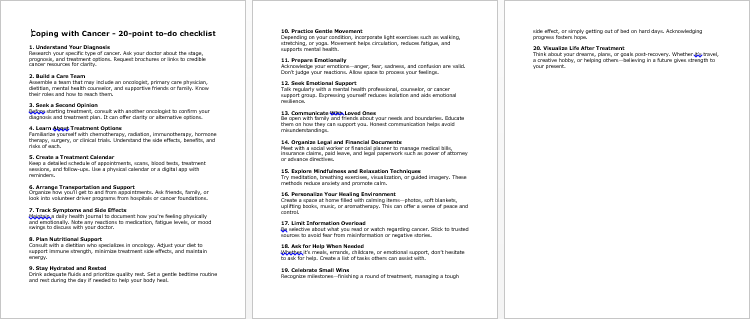
Coping With Cancer – FAQs
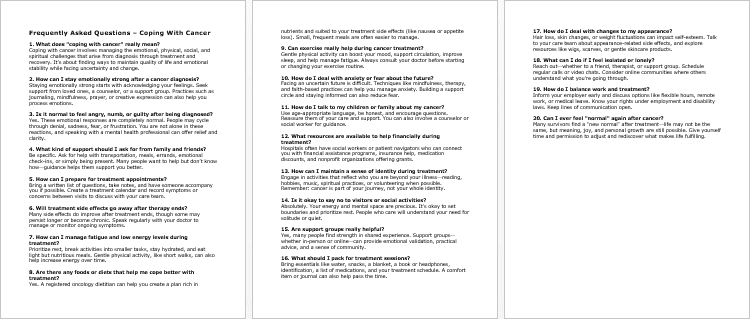
Coping With Cancer – Salespage Content
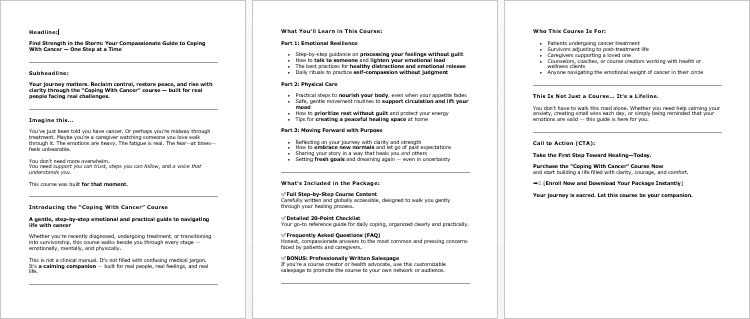
Package Details:
Word Count: 18 459 Words
Number of Pages: 88
Coping With Cancer – Bonus Content
Checklist
Word Count: 568 words
FAQs
Word Count: 545 words
Salespage Content
Word Count: 771 words
Total Word Count: 25 718 Words
Your PLR License Terms
PERMISSIONS: What Can You Do With These Materials?
Sell the content basically as it is (with some minor tweaks to make it “yours”).
If you are going to claim copyright to anything created with this content, then you must substantially change at 75% of the content to distinguish yourself from other licensees.
Break up the content into small portions to sell as individual reports for $10-$20 each.
Bundle the content with other existing content to create larger products for $47-$97 each.
Setup your own membership site with the content and generate monthly residual payments!
Take the content and convert it into a multiple-week “eclass” that you charge $297-$497 to access!
Use the content to create a “physical” product that you sell for premium prices!
Convert it to audios, videos, membership site content and more.
Excerpt and / or edit portions of the content to give away for free as blog posts, reports, etc. to use as lead magnets, incentives and more!
Create your own original product from it, set it up at a site and “flip” the site for megabucks!
RESTRICTIONS: What Can’t You Do With These Materials?
To protect the value of these products, you may not pass on the rights to your customers. This means that your customers may not have PLR rights or reprint / resell rights passed on to them.
You may not pass on any kind of licensing (PLR, reprint / resell, etc.) to ANY offer created from ANY PORTION OF this content that would allow additional people to sell or give away any portion of the content contained in this package.
You may not offer 100% commission to affiliates selling your version / copy of this product. The maximum affiliate commission you may pay out for offers created that include parts of this content is 75%.
You are not permitted to give the complete materials away in their current state for free – they must be sold. They must be excerpted and / or edited to be given away, unless otherwise noted. Example: You ARE permitted to excerpt portions of content for blog posts, lead magnets, etc.
You may not add this content to any part of an existing customer order that would not require them to make an additional purchase. (IE You cannot add it to a package, membership site, etc. that customers have ALREADY paid for.)
Share Now!

